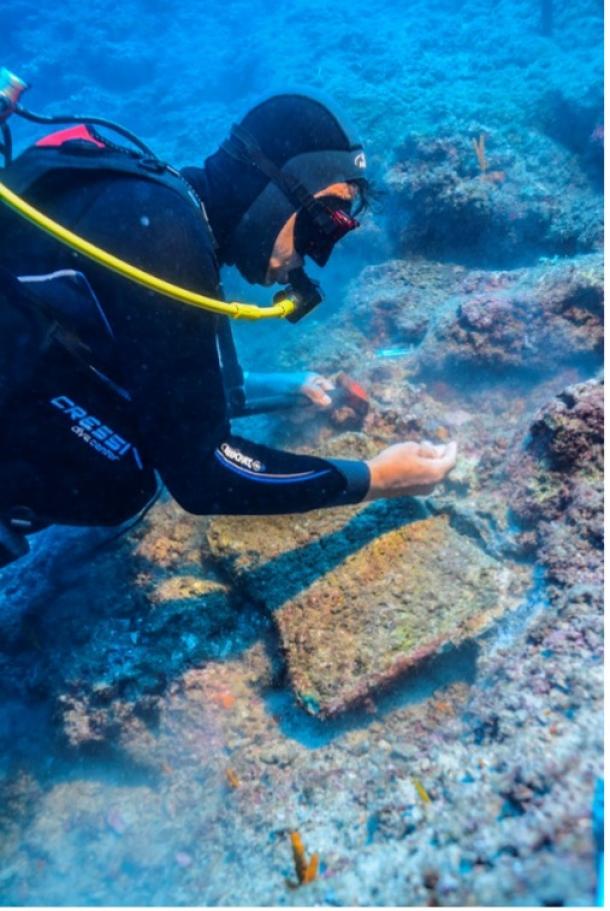
3,600-Year-Old Bronze Dagger Recovered from World’s Oldest Shipwreck
A thrilling underwater adventure off the coast of Kumluca, Antalya, has just unearthed a dazzling bronze dagger with silver rivets, believed to be around 3,600 years old, from the time of the mysterious Cretan-Minoan civilization! Hidden in the waters of the Mediterranean for millennia, the work on the vessel, which sank in ancient Lycia, began in July and August 2019. To put it into context, the shipwreck find is seen as one of the most exciting underwater archaeology finds in the history of the world!
Türkiye’s Culture and Tourism Minister Mehmet Nuri Ersoy announced the find on X, stating:
"During underwater excavations conducted off the coast of Kumluca in Antalya, a bronze dagger with silver rivets, attributed to the Minoan civilization of Crete, was discovered.”
- When Julius Caesar Was Kidnapped by Pirates, he made them Increase the Ransom!
- Earliest Neolithic Boats Found in Mediterranean Date Back to 5,000 BC
Akdeniz’in derinliklerinden 3 bin 600 yıllık sır gün ışığına kavuştu. 🗡️
Antalya’nın Kumluca ilçesi açıklarında gerçekleştirilen su altı kazılarında Girit-Minos uygarlığına ait gümüş perçinli bir tunç hançer bulundu.
✨Batık, sadece Türkiye’nin değil, dünya su altı… pic.twitter.com/bgTHiJZop9
— Mehmet Nuri Ersoy (@MehmetNuriErsoy) August 29, 2024
Precious Cargo from the Troodos Mountains: A Ship Meets its Fate
The ongoing underwater treasure hunt that began 5 years ago is a team led by the intrepid Hakan Öniz from Akdeniz University. With a green light from the Ministry of Culture and Tourism, the team has been diving deep into the past.
The dagger was discovered in a sunken ship lying 50 meters (164.04 feet) below the surface, a vessel that once carried precious cargo from the Troodos Mountains in Cyprus. It’s now believed that the ship was sailing towards Crete when it met its fate, reports Anadolu Agency.
- Bronze Age Ship Found in the Mediterranean is World’s Oldest Shipwreck!
- 3,500-Year-Old Advanced Minoan Technology Was ‘Lost Art’ Not Seen Again Until 1950s

The Minoan dagger retrieved from the Kumluca shipwreck. (Ministry of Culture and Tourism)
Most Important Wreck in the Med
One of the oldest if not the oldest shipwreck anywhere in the world, the Bronze Age shipwreck was located off the coast of Kumluca, Antalya, dated to the 16th century BC. The ensuing research has focused on in situ documentation, with a limited number of samples excavated under the permission of Türkiye’s Ministry of Culture to gather more insights into the wreck.
So far, researchers have discovered lead weights unlike any found among the 350 shipwrecks identified in the Mediterranean so far. The 14-meter-long (45.9 feet) shipwreck contained 1.5 tons of copper bullion, reported Ancient Origins in 2019.
Cutting-edge technology and modern methods were employed to minimize errors. Using sonar surveys, photo scans, and photographic mosaics, the team created three-dimensional scans of the bullion, revealing that the copper was extracted from mines in Cyprus and molded in the 15th or 16th centuries BC. Research on this significant shipwreck will continue over the next five years.

INA Vice President Cemal Pulak frees a pillow ingot. (Institute of Nautical Archaeology)
Ancient Mediterranean Trading Customs: Early Maritime Dominance
Around 3,600 years ago, the Cretan-Minoan civilization was a dominant maritime power in the eastern Mediterranean, renowned for its extensive trade networks. These trade routes connected the Minoans with various regions, including Egypt, the Levant (modern-day Syria, Lebanon, and Israel), Anatolia (modern-day Turkey), Cyprus, and the Greek mainland.
The Minoans were skilled seafarers, and their ships facilitated the movement of goods across vast distances, establishing Crete as a crucial hub in the ancient world.
The Minoans traded a wide variety of commodities, both importing and exporting goods. They were particularly known for their role in the trade of metals. Copper, which was crucial for making bronze, was imported primarily from Cyprus, while tin—an equally important component of bronze—was sourced from regions as distant as modern-day Afghanistan or Cornwall in England. The Minoans not only traded raw metals but also manufactured bronze tools, weapons, and artifacts, which they then exported across the Mediterranean.
The Minoans also exported luxury goods such as olive oil and wine; their pottery, known for its designs and craftsmanship, was another significant export. In return, they imported luxury items such as gold, ivory, and precious stones, which were used in Minoan art and religious practices.
During this period, Egypt was a dominant power in the region, and the Minoans likely engaged in trade with the Egyptians, exchanging goods and cultural influences. The Minoans may have also been involved in paying tribute or taxes to Egypt, particularly in the form of copper ingots, which were essential for maintaining Egypt's bronze production – this was likely what was seen in the shipwreck where the dagger has just been recovered.
Top image: Hakan Öni releasing the Bronze dagger from the seabed. Source: Ministry of Culture and Tourism
By Sahir Pandey
References
Büyükyıldırım, O. 2024. 3,600-year-old bronze dagger with silver rivets found in a shipwreck in Antalya. Available at: https://anatolianarchaeology.net/3600-year-old-bronze-dagger-with-silver-rivets-found-in-a-shipwreck-in-antalya/.
DS. 2024. 3,600-year-old bronze dagger discovered in Antalya underwater excavation. Available at: https://www.dailysabah.com/arts/3600-year-old-bronze-dagger-discovered-in-antalya-underwater-excavation/news.















